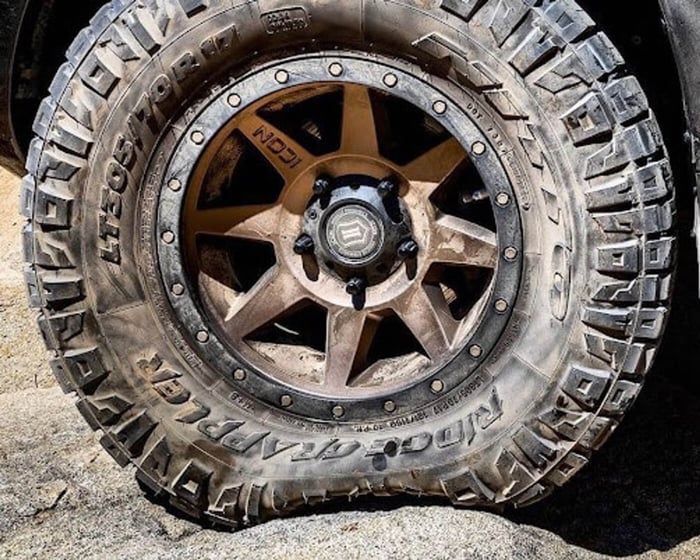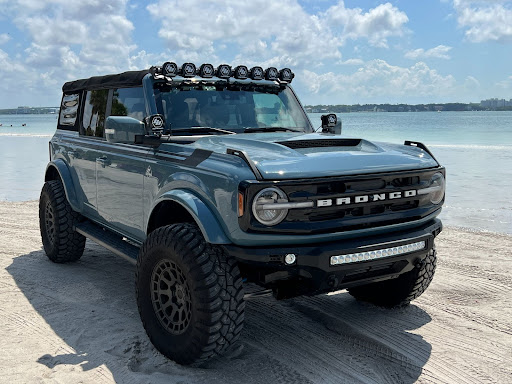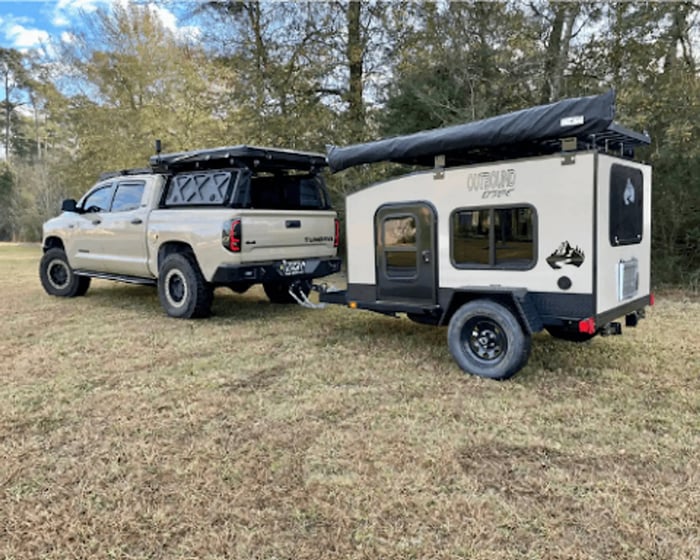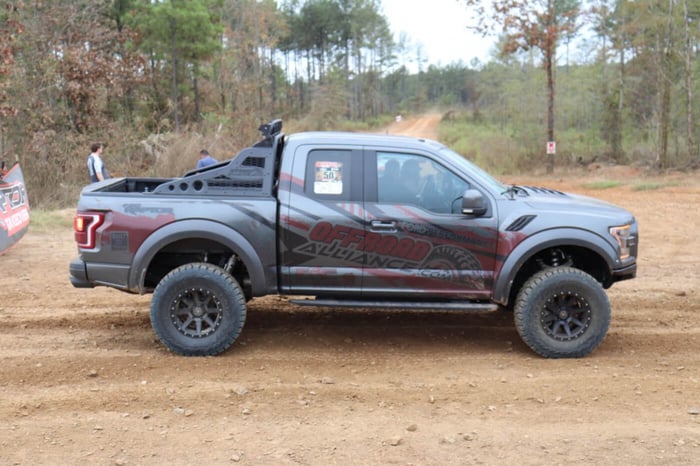
All About Air: A Guide to Tire Pressure for Different Terrain
Running with the correct tire pressure helps you guide your off-road truck or SUV over, across, and through tough obstacles that road vehicles could never manage. Your tires are the only part of the vehicle that is designed to intentionally be in contact with the ground, through which your motor’s power, suspension’s shock absorption, and your steering control maneuvers are transferred to the ground you’re traversing. We’ve talked before about the practice of airing down your tires for better traction, and if this is your first blog with us, you’ve heard it from other pros on trails, tracks, and rocks you’ve visited. In this tire pressure guide, we’re going to talk about how low you can go and how low you should go when you get off the road and start playing dirty.

Letting It Go
Your tire’s traction and energy exchange are transferred through the wheels to your tire’s tread on the ground. When you air down your tires, the pressure pushing out in all directions against your wheel and rubber lessens, the sidewall begins to bow, and more tire comes into contact with the ground. This softer tire conforms better to uneven terrain. At extremes, it bends and molds itself more completely around rocks and other obstacles. This can improve traction but it comes with some caveats:
- Fuel Efficiency: Yes, off-roaders can absolutely still care about fuel efficiency. After all, no gas, no go. When you air down, you decrease the diameter of the tire. Softer tires also deliver power better but convert it less efficiently. Combined, this means burning more fuel to get you where you need to go.
- Heat: A less dense tire heats up faster. As heat builds, performance can suffer, and eventually, the heat build-up, if left unchecked, can result in damage that leads to tire failure.
- Tire Health: Tires are designed to run at the correct tire pressure when longevity estimates are calculated. More rubber on the ground means the tire is taking on more wear than anticipated, and this can lead to shorter-lived tires.
- More Prone to Cuts: In addition to increased wear, the softer nature of underinflated tires makes it easier for sharp rocks to cut through the rubber sidewalls, which are thinner than the tread areas.
- Unseating: On most rims, tires are held in place by air pressure, with the bead of the tire pressed firmly against the lip of the rim, creating an airtight seal. With low enough air pressure, the tire’s bead can unseat from the rim, losing the seal and its positioning completely.
- Voided Warranty: Your warranty, and often any hazard protection add-on, coverage is offered on the condition the tires are used in accordance with the manufacturer’s guidelines. Airing down for off-roading is not in those guidelines. While off-road tire manufacturers certainly know their customers are airing down and engineer their tires for extended life off the road, you won’t find manufacturer guidelines beyond the correct tire pressures for road use.
With all that can go wrong, why do we even bother airing down our tires? Because if we were only concerned with gentle driving, we’d only drive subcompacts on city streets. You bought an off-road truck and started customizing it to push the limits of what you can do with a modded vehicle off the road. Your tires are just one more customizable tool to conquer the outdoors with.
Getting Ready For A Run
First and foremost, when you’re on the road, run the manufacturer-recommended road pressure on your tires. Use a reliable tire gauge to make sure your pressure is on point before you head out for the day and before you get back on the road after you’ve been in the field. You’ll also want to make sure you have the right equipment to get started.
- Fuel Efficiency: Yes, off-roaders can absolutely still care about fuel efficiency. After all, no gas, no go. When you air down, you decrease the diameter of the tire. Softer tires also deliver power better but convert it less efficiently. Combined, this means burning more fuel to get you where you need to go.
- Heat: A less dense tire heats up faster. As heat builds, performance can suffer, and eventually, the heat build-up, if left unchecked, can result in damage that leads to tire failure.
- Tire Health: Tires are designed to run at the correct tire pressure when longevity estimates are calculated. More rubber on the ground means the tire is taking on more wear than anticipated, and this can lead to shorter-lived tires.
- More Prone to Cuts: In addition to increased wear, the softer nature of underinflated tires makes it easier for sharp rocks to cut through the rubber sidewalls, which are thinner than the tread areas.
- Unseating: On most rims, tires are held in place by air pressure, with the bead of the tire pressed firmly against the lip of the rim, creating an airtight seal. With low enough air pressure, the tire’s bead can unseat from the rim, losing the seal and its positioning completely.
- Voided Warranty: Your warranty, and often any hazard protection add-on, coverage is offered on the condition the tires are used in accordance with the manufacturer’s guidelines. Airing down for off-roading is not in those guidelines. While off-road tire manufacturers certainly know their customers are airing down and engineer their tires for extended life off the road, you won’t find manufacturer guidelines beyond the correct tire pressures for road use.
Guide To Tire Pressure Off The Road
Now that you have the right equipment ordered, you need to know how to get the most out of it on your customized vehicle. We’ll talk about numbers in a moment, but first, you need to understand that every vehicle, level of driving skills, and course are different. These numbers give you a good starting point, but you will need to use your own developing experience to determine how high or low your correct tire pressure is for a successful outing.

- For uneven ground, dry but loose terrain, and mild to moderate trails: You don’t need a lot of help here. Standard off-road tread and your vehicle’s suspension and transmission will eat this alive, but airing down by about 25% will improve your traction and give you a gentler ride without making your tires too soft.
- Wet, hard ground and crawling rocks: Under these conditions, a softer, more flexible tire can really pay off. Softer tires give you more surface area on slippery surfaces and they mold themselves better to the hard, uneven surfaces of rocks and boulders. A good tire pressure guide for these conditions is to start at about 35% below your normal tire pressure.
- Soft, sloppy ground, loose sand, or while mudding: When the trail gets really nasty, you need tires that provide traction without digging themselves in. You need soft rubber that “floats” through the obstacle. A starting place around 50% should get you close to the correct tire pressure, and running lower may be possible with wheels that help lock your tire’s bead in place.
Find Your Vehicle’s Sweet Spot
As you gain experience off the road, your vehicle will guide you to the tire pressure that is right for you under field conditions. We’ve got your back with the quality aftermarket parts and life-learned experience that comes with being avid off-roaders ourselves. Set your vehicle to the correct tire pressure, get out of the garage, and into some fun with your custom vehicle and Offroad Alliance.



